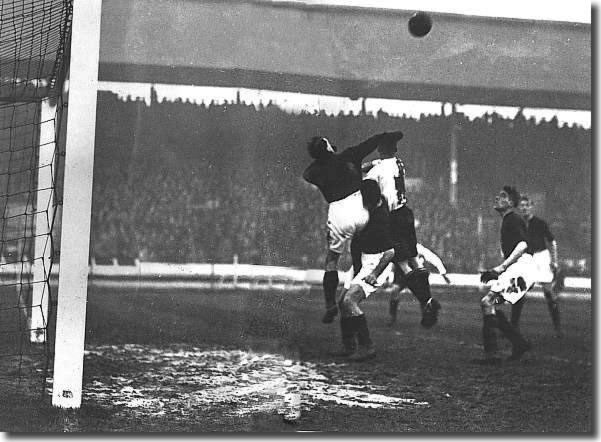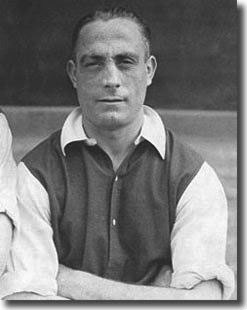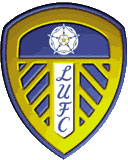|
 1930/31 had promised great things for Leeds United,
but in the end all it delivered was relegation. Manager Dick
Ray made a number of changes in the close season to try and address
the problems.
1930/31 had promised great things for Leeds United,
but in the end all it delivered was relegation. Manager Dick
Ray made a number of changes in the close season to try and address
the problems.
The previous season, he had sold John White, Eric Longden and Harry Roberts,
and in the summer he continued clearing the decks. George Reed, Tom Jennings,
Bill Johnson, Ben Underwood and Tom Mitchell all departed. Before the
end of October, Russell Wainscoat and Tom Townsley followed them. The
departure of Jennings in June to Chester was a sad one - the centre-forward
had enjoyed the most productive of stays with 112 goals in 167 appearances
in the league since arriving in 1925. The only new men that Ray brought
in were left-half Tom Neal and goalkeepers Reg Savage and Stan Moore.
Ray felt his team had been unlucky and knew from recent experience that
descent into the Second Division was not a disaster. Already new forwards
had appeared when regulars Jennings and Charlie Keetley became injured
or lost form: inside-left Billy Furness, from non-league Unsworth Colliery,
played most of the season, Tom Cochrane had replaced Tom Mitchell on the
left wing and Harry Duggan would take over from Bobby Turnbull on the
right.
Essentially Ray stuck with the men he had during the relegation year,
goalkeeper Jimmy Potts, full-backs Jack Milburn and Bill Menzies, the
brilliant half-ack line of Willis Edwards,
Ernie Hart and Wilf Copping, and
the forwards Joe Firth, Keetley, Cochrane, Furness and Duggan. Arthur
Hydes, signed in 1930, had a few games up front, but was still a force
for the future. There was a lot of class at the club and they now had
a smattering of Division One experience, making them strong candidates
for a quick return to the top flight.
They did not disappoint their fans and, as with previous seasons, went
off at pace, winning their first two matches. They then had two home defeats,
both by 1-0, against Barnsley and Millwall, before embarking on a 15 match
unbeaten run, which lasted until December 19 when they went down 2-1 at
Southampton. That run included nine straight wins. Those 15 games resulted
in 41 goals for with only 14 against, prime form, including five goal
wins against Oldham, Manchester United (who had been relegated with them)
and Burnley. Keetley was finally established as first choice centre forward
following the departure of Jennings and he was revelling in the Second
Division, scoring 15 goals before the turn of the year. Billy Furness
had amassed 10 goals and Joe Firth 8.
The Southampton defeat also saw an injury to inspirational captain and
right-half Willis Edwards, who was by now a seasoned England international,
having won 16 caps between March 1926 and November 1929. He only played
in half of the remaining games with Cyril Hornby and Alex Stacey being
called up as cover.
Edwards was a key figure in the Leeds side and they certainly missed
his presence. His injury problems heralded a worrying slip in form and
the club had some hiccups during December, including a 3-0 reversal at
Bradford. They managed to recover sufficiently to win three consecutive
league games around the turn of the year.
Another FA Cup dismissal at the first stage at the hands of Third Division
opponents, this time QPR, was disappointing, but not unusual, and knocked
United off their stride in the league. They started dropping points regularly
and gained just eight from the last 10 matches, as their scoring form
deserted them.
back to top
They'd already built up a sizable points tally, however, and in the end
there wasn't too much damage done. For some time, Leeds' only real rivals
for the promotion places were Wolves and Stoke. Leeds had beaten them both at
Elland Road in October, and the crucial returns resulted in a 1-1 draw
at Molineux on 27 February and a 4-3 win at Stoke on 12 March. Those points
were crucial in the end and Leeds were able to secure promotion as runners-up
to Wolves. They could have finished with the same number of points as
the champions had they not lost their final game, 2-0 at home to another
Midlands club, Port Vale. The win enabled Vale to avoid relegation.
promotion places were Wolves and Stoke. Leeds had beaten them both at
Elland Road in October, and the crucial returns resulted in a 1-1 draw
at Molineux on 27 February and a 4-3 win at Stoke on 12 March. Those points
were crucial in the end and Leeds were able to secure promotion as runners-up
to Wolves. They could have finished with the same number of points as
the champions had they not lost their final game, 2-0 at home to another
Midlands club, Port Vale. The win enabled Vale to avoid relegation.
It was disappointing that there was no silverware at the end of a wonderful
season but it was promotion that was the goal. A two-point margin over
Stoke was enough to signal the return of the yo yo club to the top flight.
Keetley ended top scorer with 23 goals from his 37 appearances. Crowds
had continued to dip with relegation, however, and the average attendance
at Elland Road was just above 14,000, the lowest level since 1922/23.
Less than 10,000 plucky souls watched the final match against Port Vale.
Other Football Highlights from 1931-32
- Sectarianism in Scotland took a macabre, ghoulish turn when Celtic's
brilliant 23 year old keeper, John Thomson, died in hospital five hours
after a collision in the match between Rangers and Celtic at Ibrox on
September 5. Thomson, who had won four Scotland caps, fractured his
skull when he dashed out of his area and dived at the feet of Sam English
as they both went for a 50-50 ball. Although neutral observers attached
no blame to English for Thomson's death, bigoted crowds did and claimed
the accident was deliberate. English, who had been devastated by the
incident was barracked mercilessly. In an attempt to escape the morbid
taunts he moved to England a year later and played for Liverpool. However,
the tragedy still haunted him, and, disillusioned, he eventually returned
to his native Ireland
- Everton, who had stormed out of the Second Division the previous season,
went on a goalscoring spree in the First, particularly at Goodison where
they notched up 84. In total Everton amassed 116 goals with Dixie Dean
on target 44 times. They finished two points clear of Arsenal, who beat
them home and away, but were distracted by their second FA Cup final
in two years
- Arsenal finished Double runners up as they lost 2-1 to Newcastle after
being a goal up. Newcastle's equaliser after 38 minutes was controversial,
to say the least. Right winger Jimmy Richardson sent over a centre for
Jack Allen to score, but photographic evidence clearly showed that the
ball had gone over the goal line before it was pulled back.
- England wrapped up the Home International Championship with a 3-0
victory over Scotland at Wembley, finishing with maximum points and
a 12-3 goal record. England's experimental line up against the Scots
included five new caps
- England also avenged their 4-3 defeat in Madrid in 1929 with a 7-1
demolition of Spain at Highbury in December
|












 1930/31 had promised great things for Leeds United,
but in the end all it delivered was relegation. Manager Dick
Ray made a number of changes in the close season to try and address
the problems.
1930/31 had promised great things for Leeds United,
but in the end all it delivered was relegation. Manager Dick
Ray made a number of changes in the close season to try and address
the problems. promotion places were Wolves and Stoke. Leeds had beaten them both at
Elland Road in October, and the crucial returns resulted in a 1-1 draw
at Molineux on 27 February and a 4-3 win at Stoke on 12 March. Those points
were crucial in the end and Leeds were able to secure promotion as runners-up
to Wolves. They could have finished with the same number of points as
the champions had they not lost their final game, 2-0 at home to another
Midlands club, Port Vale. The win enabled Vale to avoid relegation.
promotion places were Wolves and Stoke. Leeds had beaten them both at
Elland Road in October, and the crucial returns resulted in a 1-1 draw
at Molineux on 27 February and a 4-3 win at Stoke on 12 March. Those points
were crucial in the end and Leeds were able to secure promotion as runners-up
to Wolves. They could have finished with the same number of points as
the champions had they not lost their final game, 2-0 at home to another
Midlands club, Port Vale. The win enabled Vale to avoid relegation.